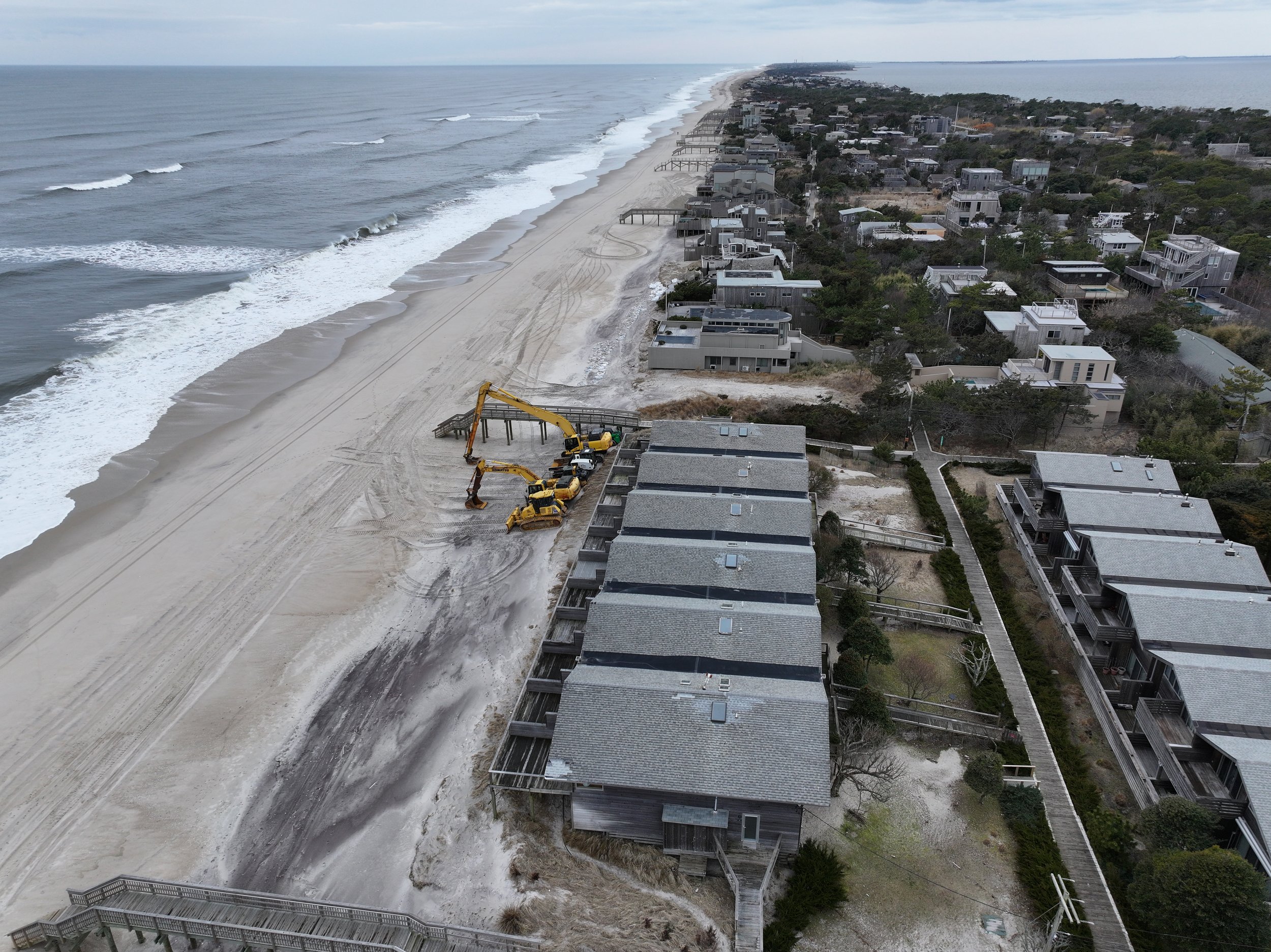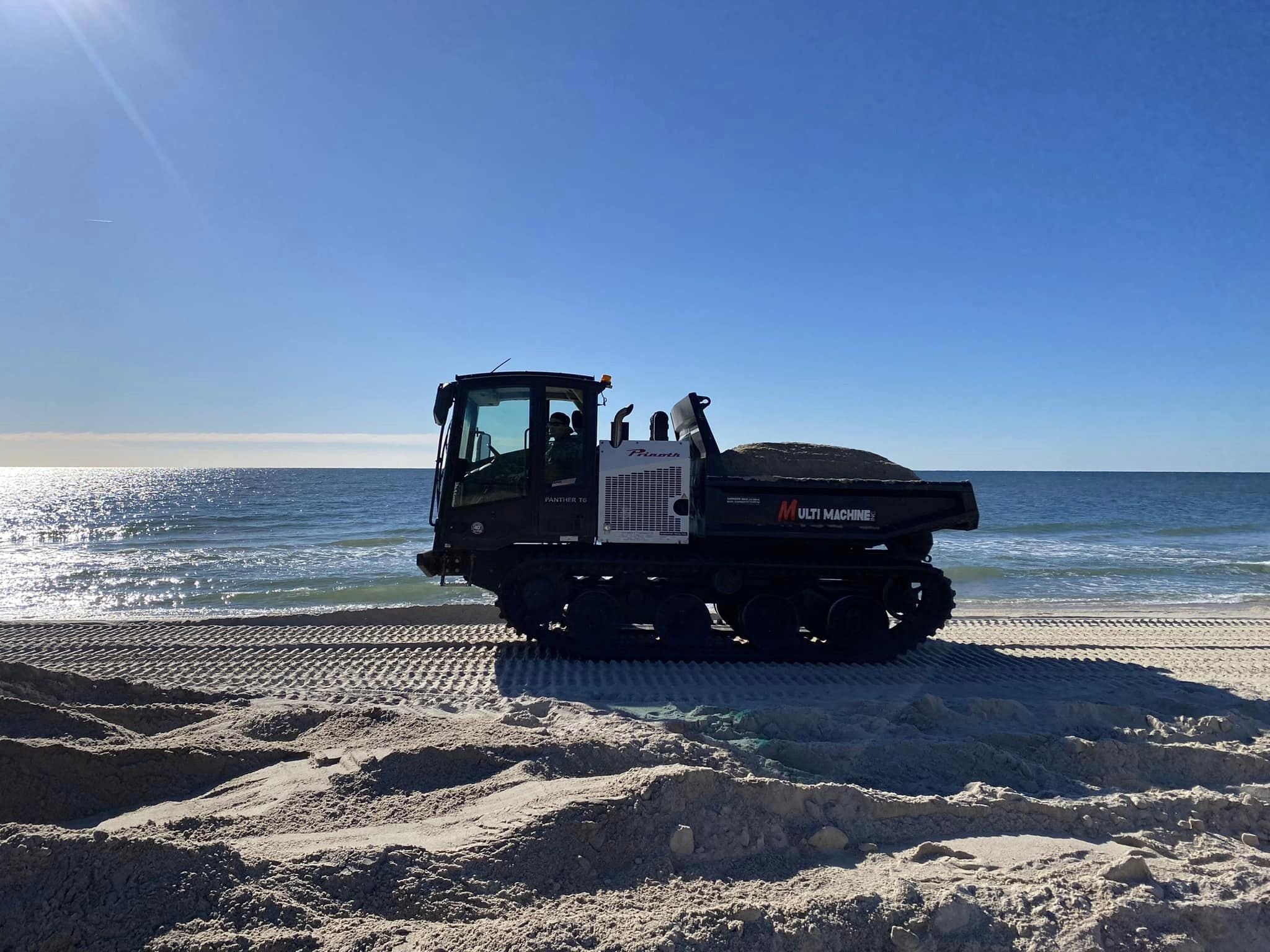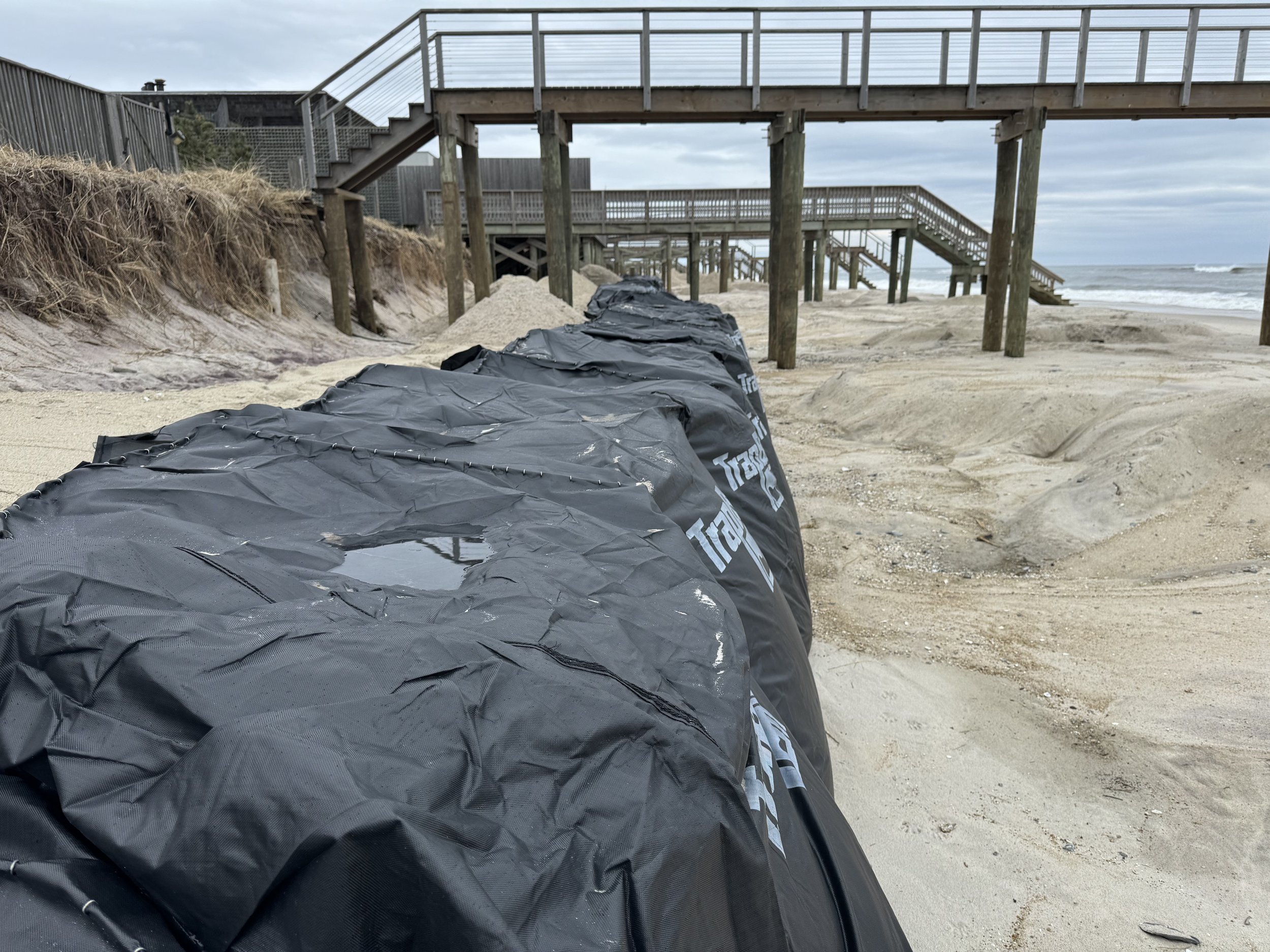
Drone footage of sand fortification at Fire Island Pines. Photo by Michael Fisher.
By John Anner
Invited to inspect the beach at Fire Island Pines after the recent string of winter storms, Councilman Neil Foley from Brookhaven was shocked at what he saw. “I was just floored,” he told me. “There was no beach left, no berm, even the dune was gone. The next thing to go would be the homes.”
In fact, according to Fire Island Pines Property Owners Association (FIPPOA) President Henry Robin, the problem had started much earlier. “We had significant damage in December 2022 from the storm named Elliot,” he explained. “That’s when we really started moving into action.”
Robin began mobilizing his neighbors in the Pines in early 2023 to figure out how to get the relevant government agencies to deliver sand and rebuild the beach. The events of late 2023 and early 2024, however, suddenly required a much greater level of effort and mobilization, one that eventually involved both New York Senators – Charles Schumer and Kirsten Gillibrand – local council members and government agencies on Long Island, governor Kathy Hochul, various contractors and the Army Corps of Engineers. The result was “a minor miracle,” said Robin. “At any point in time, the whole thing could have fallen apart.”
By mid-February, the Pines and Davis Park were getting help – giant sandbags called “trap bags” are being laid in a grid pattern on the beaches, and in some cases, sand is being dumped as a temporary measure. This stopgap almost did not happen. It’s a story of perseverance, timely interventions, bipartisan cooperation, some frankly astonishing serendipity, and a government agency not known for its alacrity leaping into action.
“It’s an amazing thing, really,” laughed Andrew Kirtzman, a Pines resident and FIPPOA board member, after detailing the hard-to-believe chronology of how the stopgap beach restoration was approved and implemented.
Historical Precedent
Fire Island would not be the idyllic refuge it is today were it not for the heroic actions of local citizens who fought the state to prevent it from building a highway down the middle of the island from Jones Beach to Montauk in the 1960s. The uber developer Robert Moses actually got funding to build a 43-mile highway from Fire Island inlet to South Hampton, and work was about to begin when a congressman from South Hampton named Stuyvesant Wainwright began a campaign to stop the construction. On September 11, 1964, President Lyndon Johnson signed the Fire Island National Seashore Bill, thus forever putting the federal government in charge of Fire Island’s fate. However, as organizers in 1964 showed, when committed citizens join forces with local supporters, they can move the mighty and intransigent federal government – and even the Army Corps of Engineers.
Winter Storm Damage
As the first winter storms hit in December 2023, residents all up and down Fire Island watched with alarm as the beaches eroded rapidly. In some cases, like in Robbins Rest, dune wash over almost touched the Great South Bay. Further east, already degraded beaches were even much harder hit. From Davis Park to Fire Island Pines, and west to Point O Woods, storm waves scoured the sand from under the walkovers, carrying away railings and stairs. Ocean water overtopped the dunes in many places, flooding directly under homes.
Meanwhile, to the west, a dredging contractor called Great Lakes hired by the Army Corps of Engineers was sucking up huge amounts of sand and spewing it all over the beaches from Seaview past Atlantique. I had a front-row seat from my home in Atlantique for the show put on day and night by massive bulldozers that clanked and roared and expertly shaped the piles of wet sand into new dunes, which are now planted with dune grass in neat rows.
That project, however, ended about two-thirds of the way through Seaview. Why two-thirds? Because while the western two-thirds of Seaview belongs to the town of Islip, the eastern third is part of Brookhaven, which was not included in the plan to renourish the Islip beaches. And those few blocks of beach, like the eastern towns, were eroding rapidly, much to the dismay of Seaview Association president Tom Ruskin.
“When I heard that folks in the Pines were trying to do something to save the dunes,” said Ruskin. “I picked up the phone and called Henry.”
By this point, FIPPOA President Robin was in full battle mode. A retired private equity professional who has been frequenting the Pines for decades, Robin sought help wherever he could find it.
“I had 10 [Pines] community members with political connections on the federal level,” he explained. “That’s how we got to Senators Charles Schumer and Kirsten Gillibrand.”
When Robin got the call from Ruskin, another major piece fell into place. The two men decided to hire the global public and government relations firm Actum, which had access to New York Governor Kathy Hochul.
It would seem, with the Army Corps of Engineers already restoring the beach a few miles away, that it would be a simple matter to get them to spray a few hundred cubic yards of sand in the direction of the Pines. But that’s not the way the government works.
The Army Corps turned down multiple requests for emergency help, ruling that no one storm met the definition of an emergency as they understood it. Every day that passed, the beaches became more unstable, and the contractor hired by the Army Corps (Great Lakes Dredging and Dock Co.) was one step closer to leaving Fire Island.
“Neil Foley is a real hero in this story,” said Kirtzman. “He was just a relentless advocate.”

Vehicles mobilized to transport sand due east. Photo by FIPPOA.
Foley, a Republican, had to work closely with the Democrats Schumer, Gillibrand and Hochul. When I asked him about this, he said “hey, my political party is the towns on Fire Island. I love them all, they are like my kids. When I saw what was happening, I just could not let it go.”
At one point, Foley had an idea – why not just ask the Army Corps and Great Lakes to dump a bunch of sand on the beach, and then let the towns figure out what to do with it? The only roadblock, of course, was that the Army Corps had already rejected the notion that they needed to do something immediately. Meanwhile, the staff at Actum had figured out that they could get funding for emergency work on Fire Island from a special fund available to the governor. Governor Hochul sent Suffolk County $3 million dollars.
The solution was to agree with the Army Corps that no one single storm constituted an emergency, but taken all together and defined as one occurrence, the storms added up to a genuine emergency that the Army Corps could respond to.

Trap bags being laid at Fire Island Pines. Photo by Michael Fisher.
“The elected officials lumped all the storms into one bundle,” explained Ruskin, “that then met the definition.”
With the clock ticking and all the pieces in place, one problem remained. Great Lakes was not willing to extend their work duration on Fire Island. They had critical contracts to attend to in Montauk and other locations. They were literally days away from sailing off to Montauk with the giant dredge hopper and all their bulldozers and massive pipes.
“Finally, they agreed to one day of dredging work,” said Kirtzman. “One day!”
It would turn out to be enough. “They dumped 21,000 cubic yards of sand at $22 a cubic yard on the beach in front of Atlantique, Corneille and Ocean Beach,” Ruskin said.
Foley and other elected and appointed officials in Suffolk County then contracted with a local company to move the sand to the Pines and Davis Park, with some allocated for the eastern end of Seaview as well as other communities. Point O Woods went their own way. The beaches there are also highly eroded, but the private community acted on their own to stack up trap bags until such time as a more permanent solution can be reached.
Kirtzman has an oceanfront house in the Pines. One day last week, he came to Fire Island and walked out on his back deck. When he saw what was going on, he grabbed his phone and made a Facetime call to Henry Robin. “I want you to see something,” he said, pointing the phone camera at a crane busily placing trap bags on the beach.
On the other end of the call, Robin could see the results of all of their hard work. “Andrew,” he said, “I could cry.”
The following corrections were made to this article on February 28, 2024:
• Brookhaven Councilman Neil Foley is not a member of the Conservative Party.
• Andrew Kirtzman’s conversation in the last paragraph of this article was with Henry Robin, not Thomas Ruskin.































